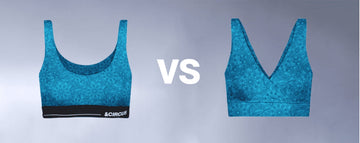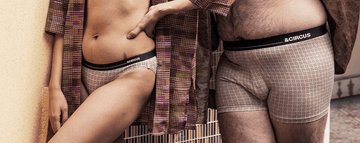Quick Listen:
When you think of a sustainable wardrobe, your mind likely drifts to organic cotton sweaters or vintage leather jackets. But what about the garments closest to your skin? Innerwear bras, briefs, and camisoles rarely gets the spotlight, yet it's a cornerstone of fashion's environmental impact. The global underwear market, valued at $94.5 billion in 2024 and projected to reach $147 billion by 2033 with a 5% CAGR, is a massive force in the industry, according to a report by Business Research Insights. Choosing sustainable innerwear isn't a minor tweak; it's a bold step toward a greener future.
The fashion world has embraced sustainability as a mandate, and innerwear is no exception. Brands like Tailor and Circus are pioneering this shift, crafting eco-friendly, inclusive designs that marry style with substance. This isn't about sacrificing comfort for ethics or settling for bland basics. It's about vibrant, thoughtfully made pieces that feel as good as they look. Let's explore how to build a sustainable wardrobe from the inside out, one conscious choice at a time.
The Rise of Sustainable Innerwear
The lingerie and underwear sector is undergoing a profound transformation. Once defined by frilly aesthetics, it now prioritizes function and sustainability. Innovations like breathable microfiber, memory foam cups, and wireless support systems have elevated comfort and wearability, reshaping what consumers expect, as highlighted in a Future Market Insights analysis. Fabrics such as organic cotton, Tencel, and bamboo are gaining prominence for their minimal environmental footprint, requiring less water and fewer chemicals than traditional cotton.
Recycled and upcycled materials are also revolutionizing the market. Picture briefs woven from repurposed plastic or bras crafted from textile scraps. The push for circular fashion creating products that can be recycled, biodegraded, or repurposed is accelerating. A Mordor Intelligence study forecasts the lingerie market to grow from $99.12 billion in 2025 to $147.55 billion by 2030, with an 8.28% CAGR, driven by these advancements. Asia Pacific, holding a 32.35% market share in 2024, leads this surge, fueled by rising incomes and eco-conscious demand, per Fortune Business Insights.
Tailor and Circus: Leading by Example
Tailor and Circus stands at the forefront of this movement, redefining innerwear with a commitment to sustainability and inclusivity. Their collections, made from bamboo and organic cotton, prioritize softness and environmental responsibility. Unlike fast-fashion brands that flood landfills with synthetic briefs, Tailor and Circus designs for durability. Their no-size underwear, part of a market expected to reach $1.22 billion by 2025 with an 8.6% CAGR through 2033, embraces body positivity through flexible, adaptive fabrics, according to Archive Market Research.
Other brands are joining the charge. Labels like Knix and Parade incorporate recycled nylon and biodegradable elastics, while smaller designers experiment with plant-based dyes. A Teen Vogue feature notes that while consumers are often urged to replace intimates every six months, sustainable brands challenge this disposable mindset with long-lasting, ethically produced pieces. Studies show that shoppers who adopt eco-friendly innerwear tend to develop strong brand loyalty, drawn to companies that reflect their values. Tailor and Circus has cultivated a devoted following through social media campaigns that celebrate diverse bodies and sustainable practices.
Navigating the Challenges
Transitioning to a sustainable innerwear wardrobe comes with obstacles. Eco-friendly materials, such as organic cotton and recycled polyester, involve complex production methods, driving up costs. A single pair of sustainable briefs can cost $20 or more, a stark contrast to fast-fashion alternatives. The global underwear fabric market is projected to hit $424.4 million in 2025, but scaling sustainable production remains a challenge, as noted in an Archive Market Research report.
Availability is another hurdle. While the sustainable innerwear market is expanding, options can be scarce in smaller markets or for specialized sizes. E-commerce has bridged some gaps, boosting access to no-size and eco-friendly brands, but the market is still maturing. Consumer awareness also lags. Many don't realize that conventional underwear, often made from petroleum-based synthetics, contributes to microplastic pollution. Educating shoppers about the environmental toll of their intimates without sounding dogmatic is a critical step.
The Rewards of Sustainable Choices
Despite these challenges, the benefits are compelling. Sustainable innerwear offers brands a chance to stand out in a competitive landscape. Direct-to-consumer models and social media have democratized access, transforming innerwear into a platform for self-expression and empowerment, as emphasized in the Future Market Insights analysis. Younger consumers, particularly Gen Z and millennials, are fueling demand for value-aligned products, with the women's underwear market projected to grow at an 8.6% CAGR through 2033, per Business Research Insights.
The environmental gains are significant. Opting for a bamboo bra over a polyester one conserves water and cuts carbon emissions. Biodegradable fabrics decompose naturally, unlike synthetics that persist in landfills for centuries. The rise of athleisure has also introduced performance fabrics, like moisture-wicking nylon, that blend sustainability with functionality. It's a rare alignment of ethics and practicality.
The Future of Innerwear
Industry experts view sustainable innerwear as a permanent shift, not a passing fad. The industry is at a turning point, a designer told Teen Vogue. Consumers demand transparency and are backing it with their purchases. Innovations like 3D-knitted bras and AI-driven sizing tools are making sustainable innerwear more accessible and tailored. The Mordor Intelligence study projects an 8.28% CAGR through 2030, with technology and education as key drivers.
Envision a future where every bra is biodegradable, every pair of boxers supports fair labor, and every purchase reduces fashion's environmental burden. That future is within reach. Brands like Tailor and Circus are paving the way, weaving style, comfort, and responsibility into every garment.
Where to Begin
Start small but think big. Open your underwear drawer and assess what's there. Replace that worn-out fast-fashion set with a piece designed to endure one that carries a story of care for the planet and its people. Seek out brands that prioritize sustainability, from their materials to their labor practices. Share your discoveries with friends, amplifying the message. The smallest garments in your wardrobe can ignite the biggest transformation in fashion.
By choosing sustainable innerwear, you're not just curating a wardrobe you're shaping an industry. The data is clear: with markets growing and consumer priorities shifting, now is the time to act. Your choices today can redefine fashion's tomorrow.
Disclaimer: The above helpful resources content contains personal opinions and experiences. The information provided is for general knowledge and does not constitute professional advice.
You may also be interested in: Knew You would love a New Us.
Uncomfortable underwear shouldn't steal your confidence. At Andcircus, we craft ultra-soft, sustainable Lenzing Modal Micro innerwear for every body, XS to 5XL. From briefs to bras, our custom packs fit you perfectly. Shop risk-free with our 100% satisfaction guarantee and embrace comfort that includes everyone. #LoveEveryBody. Shop Now!







































